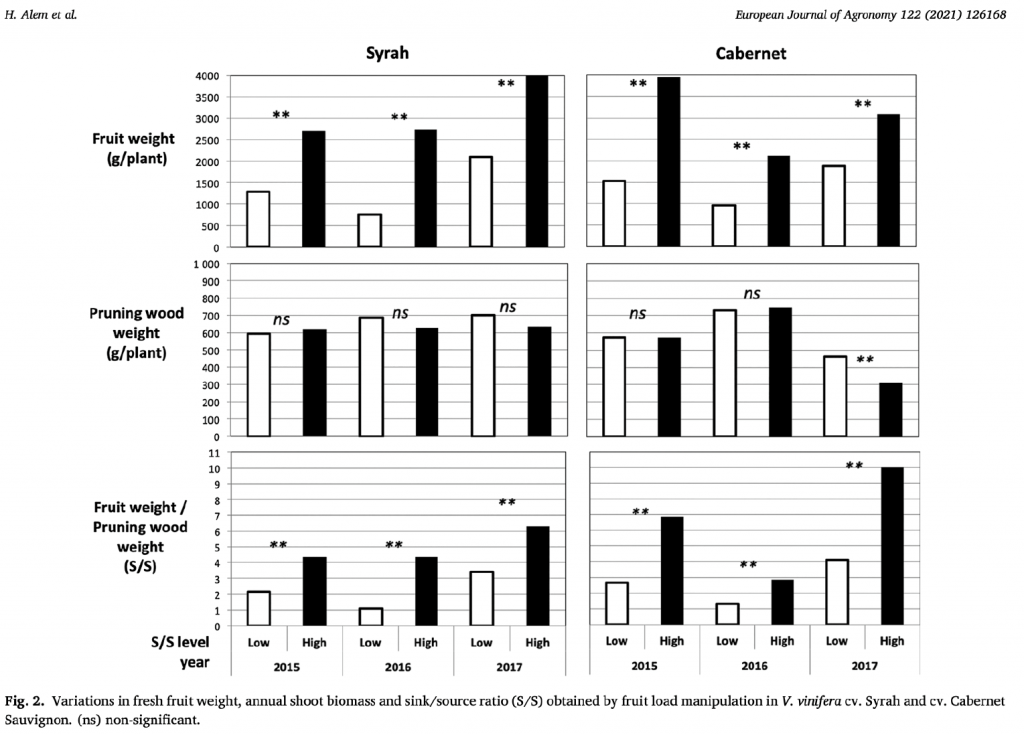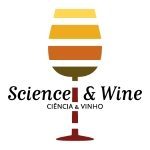By Alem H., Ojeda H., Rigou P., Sire Y., Schneider R., Torregrosa L.
Vitis vinifera grape is a non-climacteric fleshy fruit. During grape ripening, the concentrations of metabolites change as a function of the balance between biosynthesis and metabolization and growth-related dilution effects (Bigard et al., 2018 & 2020). A number of metabolites and inorganic solutes determines the quality of the wine grape, such as sugars, organic anions (i.e. tartaric and malic acids), cations (potassium) and secondary compounds (pigments, aroma precursors…).
A wide range of practices have been developed to regulate vine development or to manipulate grape microclimate, with the objective to increase the accumulation of metabolites of interest in the ripe fruit (Alem et al., 2018). The level of carbon assimilated during the season is directly dependent on climatic characteristics, i.e. light radiation and temperature (Greer & Weedon, 2012) and VPD (vapor pressure deficit). As for other perennial species, the balance between carbon sinks and sources (S/S), i.e. crop load versus vegetative organ development, has to be regulated to ensure the sustainability of the crop production. However, the regulation of fruit load is complicated as it depends on environmental conditions of the previous year but also seasonal factors. During the season, plant sink/source can be regulated by shoot (Bernizzoni et al., 2011) or bunch thinning (Gil et al., 2013), shoot tipping and leaf removal (Reynolds, 1989). The effects of these practices on fruit composition are variable depending on the year, the variety and the site of experimentation (Alem et al., 2018).

The regulation of the sink/source (S/S) balance is considered as a one of the more powerful tools to adapt grape composition to technological objectives. In grapevine, most previous studies about the effect of bunch thinning on fruit development were mainly based on the monitoring of the concentrations of metabolites. However, in the absence of consistent physiological landmarks, concentration and accumulation effects were often confused. Indeed, after phloem unloading stops at physiological ripening completion, fruit shrivelling becomes the major driver of solute concentrations (Bigard et al., 2019). Moreover, in most studies, the effect of S/S on the quantity of metabolites accumulated at plant level has not been assessed which prevents the quantitative estimation of the losses of metabolites induced by thinning practices. Finally, few studies addressed the accumulation of glycosylated aroma precursors (GAPs), a family of compounds which, due to their sugar moieties, potentially dependent on plant trophic balance. To characterize the metabolic variations induced by the manipulation of S/S, we have studied the effect of severe bunch thinning on the accumulation of primary metabolites, anthocyanins and GAPs (i.e. alcohols, C13-norisoprenoids, phenols and terpenes) at the arrest of solute imports in the grapevine fruit for an aromatic and a non-aromatic red and wine grape varieties.

In red varieties, the results demonstrated that the manipulation of the S/S doesn’t de-correlate the accumulation of secondary versus primary metabolites. Decreasing S/S drastically limited the accumulation of either primary metabolites (till -70 %), anthocyanins (till -70 %) and GAPs (till -81 %) per plant, with a huge production shortfall of molecules of interest per cultivated area unit. In white varieties, crop reduction also resulted in significant losses of metabolites to be accumulated in the fruits per plant: i.e. up to -72% for sugars, -75% for organic acids and GAPs. S/S manipulation could not modify the balance between GAPs and primary metabolites or increase the concentration in GAPs in the physiologically ripe grape.

Hubert Alem 
Hernan Ojeda 
Rémi Schneider 
Laurent Torregrosa
Hubert Alem – Hubert Alem did his PhD from 2015 to 2019 at the Intitut Agro of Montpellier and the Occitanie INRAe center of Montpellier. Researches were performed in two units: UMR SPO (University of Montpellier, CIRAD, INRAe, Institut Agro of Montpellier) and the INRAe Experimental centre of Pech Rouge. Hubert Alem scholarship was provided by Faculty of Agronomy of the University of Buenos Aires (FAUBA) and research funding was provided by the INRAe and the Institut Agro of Montpellier.
Hernan Ojeda – Research Engineer at the French INRAE on issues related to Viticulture, Ecophysiology and Grape quality. He has been Director of the Experimental Units of INRA Pech Rouge and Vassal. PhD in Agricultural Sciences from L’Ecole Nationale Supérieure d’Agronomie de Montpellier (France). He has been a Research Engineer for 10 years at INTA de Mendoza (Argentina). In 2005, he obtained the Francisco Oreglia Award for Innovation in Argentine Viticulture. Currently, vice president of the GiESCO (International Group of Experts on Viti-Vinicultural Systems for Cooperation, www.giesco.org).
Rémi Schneider – Currently technical director of Oenobrands, a company delivering biotech solution to the wine industry, Rémi Schneider was project manager in the French Wine Technical Institute (IFV) for more than 15 years. In charge of aroma and polyphenols management in wine, he developed his research in various fields such as analytical chemistry, enology and viticulture to provide tools and methods to improve and pilot wine organoleptic quality.
Laurent Torregrosa – Professor of plant biology & genetics at Institute Agro of Montpellier (National Institute of Higher Education for Agriculture, Food and the Environment). During his first position, as a research fellow, Dr. L. Torregrosa dealt with the genetic engineering of the grapevine resistance to grapevine chrome mosaic virus & powdery mildew. From 2000 to 2010, L. Torregrosa was involved in several programs to study the genetic regulation of grapevine reproductive development. Since 2011, he has been studying the impact of elevated T° and water deficit on grapevine vegetative and reproductive developments in order to identify traits of adaptation to heat and drought. Board of the International Grape Genome Program (IGGP) and the International Viticulture & Enology Society (IVES), member of the French delegation at OIV, president of the GiESCO (www.giesco.org). https://www.researchgate.net/profile/Laurent_Torregrosa

